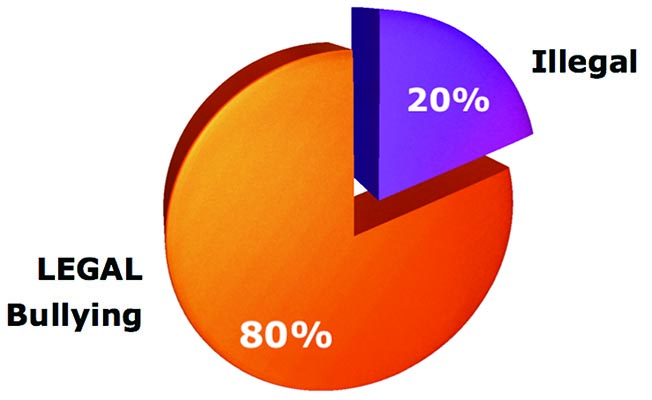What Workplace Bullying Is Not

This suggests two points: (1) bullying is much more common than illegal harassment, roughly a 4:1 ratio; and (2) that when bullied with a small part that is discriminatory, put all your emphasis in the complaint on the conduct that your employer cannot ignore — the discrimination. Bullying falls onto deaf employers’ ears.
Conflict
HR likes to force bullying or abuse, forms of non-physical interpersonal violence, into a conflict box. Bullies are irrational actors; bullying makes no sense in terms of legitimate business interests. Conflict involves two parties that can still be reasonable. Intellectual differences are not comparable to the toxic pairing of one person committed to dominating another person. A middle ground may be found using mediation when conflict is present. However, there can be no negotiation and compromise with violence. What can we ask of the previously compromised target — maybe accept beatings only 3 days a week rather than every day!
No mediation for bullying. Academics agree because it is not simple conflict between two parties with equal power.
An Acceptable Style of Managing People
Bullying is not a routine exercise of managerial prerogative. Yes, management has all rights in non-unionized workplaces. But abusing subordinates is not a successful strategy. In the short run, the fear instilled may look like it motivates workers. In the long run, fear fosters resentment and sabotage.
I’ve taught both military officers and civilian graduate management students. The latter group is much more militaristic. They act like martinets terrifying fresh recruits in boot camp. The students in the military reminded me that they arm their subordinates. This compels them to lead in ways that sustain genuine love and loyalty, lest they get fragged. What the corporate bullies forget is that boot camp is followed by lots of training and support to build both physical and mental strength.
We may never know the prevalence of bullies in organizations. They don’t offer themselves to be researched. We are certain, however, that many bullies are abusive as a cover for their own ignorance, incompetence and lack of technical prowess. The most glaring omission is their lack of skills with people. Unfortunately, these are often referred to as “soft” skills. The truth is that effective managing requires patience, an ability to teach, the reliance on approval to shape behavior, and unconditional listening to others. As long as these are neither trained anymore nor considered hiring criteria for managers, bullying will surely persist.
Counseling for Poor Performance
It angers us when genuinely poor performers accuse their managers of bullying when evaluated as a poor performer. Reasons for poor performance include: (1) the failure to train managers how to teach work skills so workers learn, (2) a poor fit between worker’s motivation and challenges inherent in, or absent from, the job, and (3) miscommunicated and misunderstood expectations about what to do and how to do it. Therefore, if the job is not right for you and will never be given who supervises you, leave. You deserve feeling comfortable and safe while working. But DO NOT claim to be bullied when called out accurately that you do not do a good job. Using bullying as a cover for the poor fit between worker and job makes it tougher on your coworkers who actually are bullied.
Now we agree that most managers do not know how to conduct performance appraisals. So there is much to improve. Our complaint only applies when the performance is truly unacceptable and you are told the truth.

